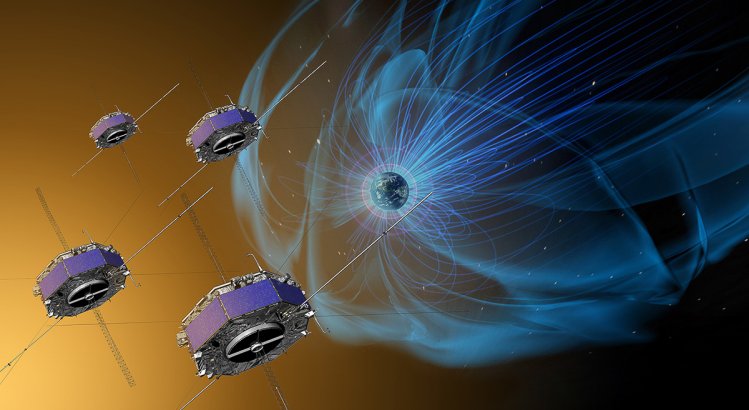
Space Plasma Physics research programme
The Space Plasma Physics research programme performs measurements of space plasma with instruments on board spacecraft and on the ground. Our specialty is measurements of electric fields and plasma density in space. We also measure wave movements in these fields and this density.
The goal of the programme is to build physical models based on measurements. The models help us understand not only space plasma around the Earth and other planets, but also corresponding processes in areas where direct measurements are impossible or very difficult, such as near the sun and other stars and in the structure of fusion plasma.
- RPF seminar
- Collisionless Shock Meeting in Uppsala (26-27 January)
- SRS 2023 in Uppsala (14-15 March)
- Swedish Plasma Meeting in Uppsala (13-14 March)
We send the in-situ instruments into space to investigate the space plasma environment around the Earth and other planets in the Solar system. Below you can read about our different research subjects.
For the moment, we are responsible for or have a significant contribution to the following instruments in space:
JUICE (JUpiter Icy moons Explorer)
An international spacecraft exploration mission to the Jovian system led by ESA launched on April 14, 2023. We lead an instrument set to characterise the plasma and waves, the Radio and Plasma Wave Investigation (RPWI).
Solar Orbiter
ESA’s mission to investigate the Sun at close distance launched on February 10, 2020. We have provided parts of the RPW instrument to study the electric field in the solar wind close to its source.
SolarOrbiter@ESA, SolarOrbiter@NASA, RPW@LESIA
BepiColombo
An ESA-JAXA (Europe-Japan) mission to Mercury, where we are responsible for the electronics and probe surfaces for the MEFISTO sensors of the PWI instrument on the magnetospheric orbiter. Launched in October 2018 for arrival at Mercury 2026. More on Bepi and MEFISTO at KTH.
BepiColombo@ JAXA, BepiColombo@IRF
4 x MMS
NASA’s Magnetospheric MultiScale mission, launched on March 13, 2015, for which we provided sensor coating and test equipment for the electric field instruments built by the University of New Hampshire and the Royal Institute of Technology (KTH). More info on the SMART instrument suite for MMS at SwRI.
3 x Swarm
ESA’s three satellites for the study of the geomagnetic field launched on November 22, 2013. We provide instruments to measure the plasma density and temperature in the Earth’s ionosphere.
4 x Cluster
Our instruments are exploring Earth’s magnetosphere on a flotilla of four ESA spacecraft launched in the summer of 2000.
Comet Interceptor
ESA’s mission to a comet so new that it may not have been discovered even when we launch in 2028! Together with LPC2E in Orléans and a larger European collaboration, we provide instrumentation for investigating the comet plasma environment.
Rosetta (2004-2016)
ESA’s spacecraft Rosetta completed a two-year survey of comet 67P / Churyomov-Gerasimenko. We have built the Langmuir probe instrument (LAP) to investigate the cometary environment.
Cassini-Huygens (1997-2017)
NASA/ESA/ESA joint mission to Saturnian system. After seven years in space, Cassini went into orbit around Saturn on July 1, 2004. Our Langmuir probe instrument was onboard for investigating the space physics of the Saturn system, including its rings and moons, such as Titan and Enceladus. In 2017, Cassini spacecraft operated a planed crush into Saturn’s atmosphere and provided the data of the gas giant’s atmosphere for the first time.
Cassini@NASA, Cassini@ESA, Cassini@IRF
Smart-1
SWARM orbited the moon with our Langmuir probes onboard, launched September 2003, impact landing on the moon 3 September 2006.
Astrid-2
The Swedish microsatellite (only 29 kg) carrying our LINDA instrument to the Earth’s upper ionosphere 1998-1999.
Freja
Freja did detailed measurements of the Earth’s upper ionosphere from 1992-1996, including our wave investigations.
Viking
Exploring the Earth’s magnetosphere 1986-1987 by means of our wave instrument (and, of course, other instruments as well).
We also add numerous sounding rockets during the sixties, seventies, and eighties.
As a direct application of the programme’s fundamental research, we have since 2016 led a project to improve space weather forecasts and help protect infrastructure, which is critical to Swedish society.
SHARP (SHocks: structure, AcceleRation, dissiPation) is an international collaboration program for understanding the collisionless shock structures funded by the European Union. IRF leads a work package to develop a database of in-space collisionless shocks around Earth, Mars, Venus, and interplanetary space.
Software projects developed in IRF Uppsala can be found from the following links:
Employees in the space plasma physics programme can be found in Uppsala.
